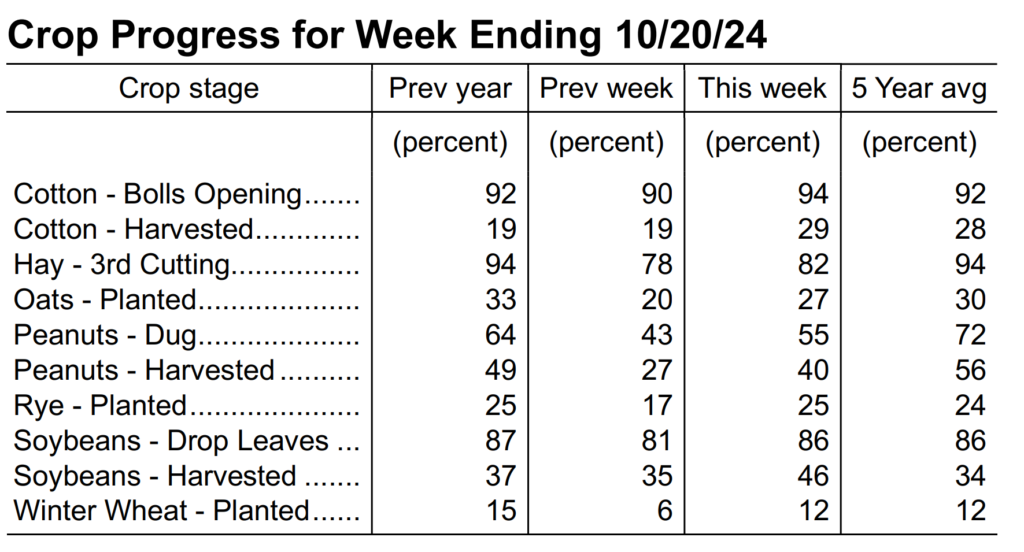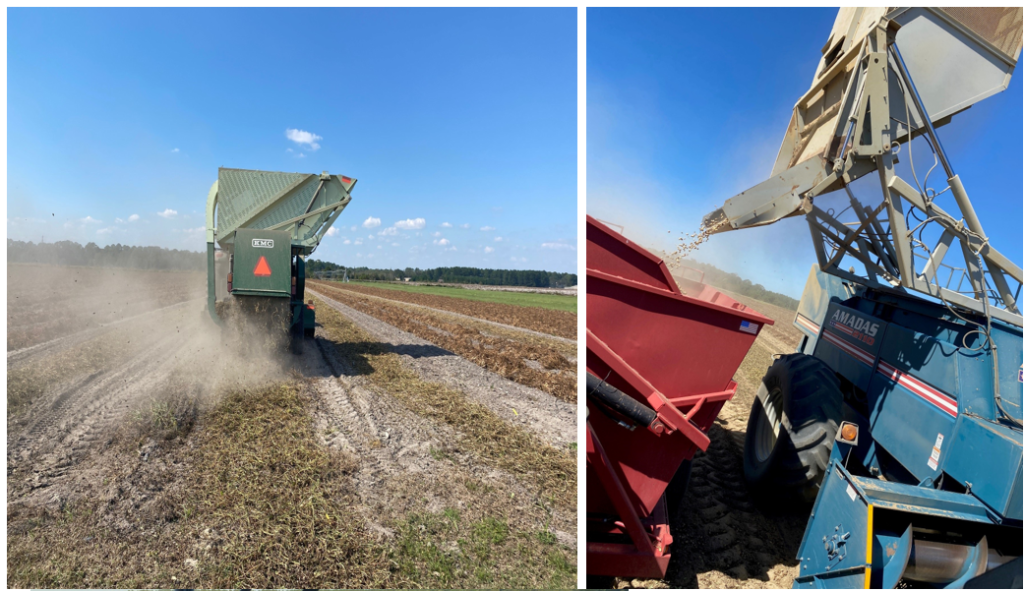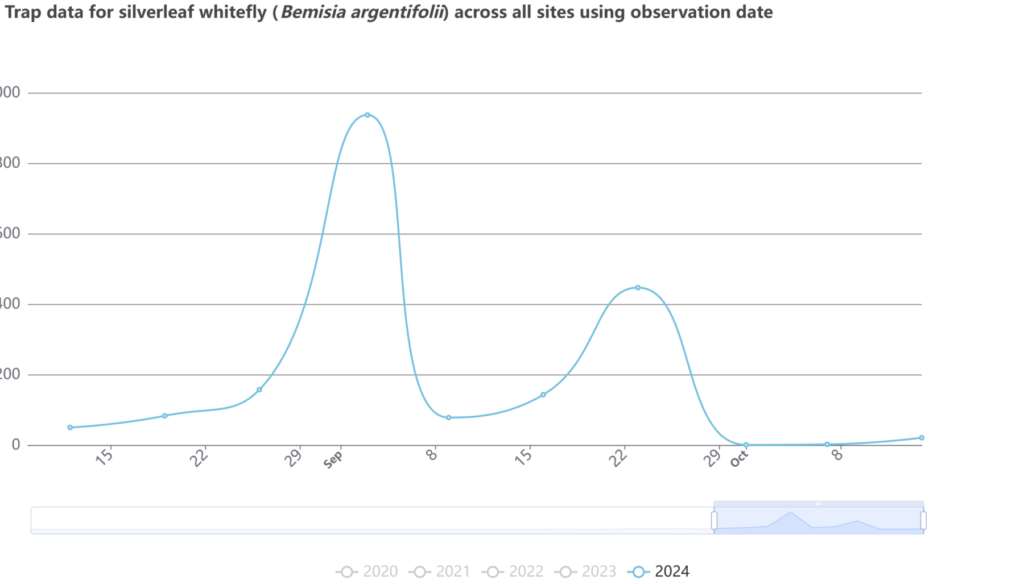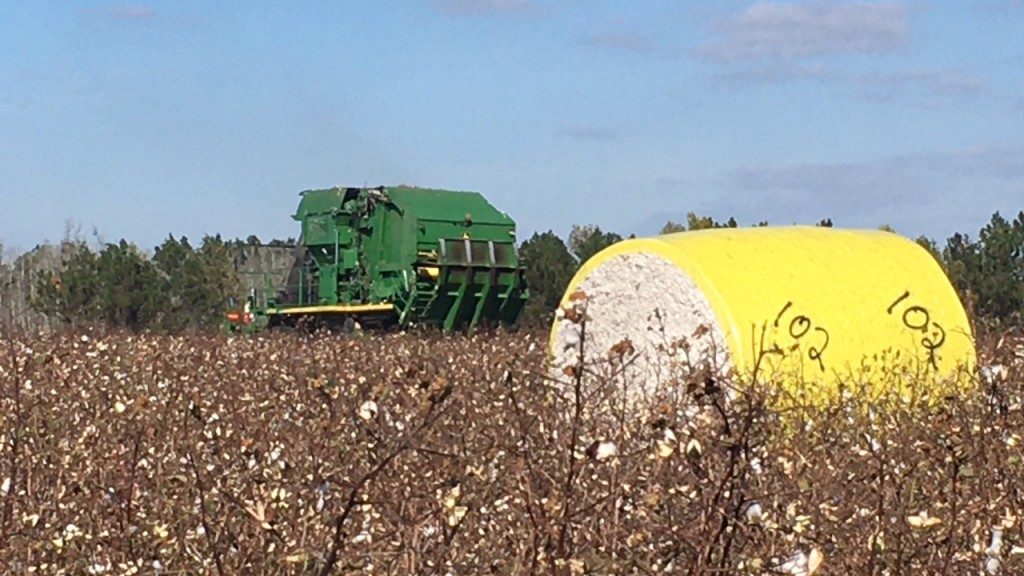Current situation: Dry weather has been great for harvesting cotton and peanuts. Growers have started to water peanut fields in order to dig them. Dr. Wes Porter, UGA Irrigation Specialist, suggests watering peanuts 0.5” 1 to 2 times a week or 0.75” every week and a half. Water requirements for peanuts decrease as they reach maturity. The water use for peanuts decreases in the last couple of weeks before harvest. The water requirement for peanuts two weeks before digging is 0.3 inches per week and decreases to 0.14 inches per week before digging (UGA Irrigation Reference Guide). According to the Georgia Crop Progress and Condition Report, released on October 21, 2024, 29% of the cotton crop has been harvested and 55% of the peanut crop has been dug in Georgia. If you need to have a peanut maturity check please call or txt me and we can arrange for that to happen.


The link to latest edition of All about the pod. In this episode, Dr. Scott Monfort talked peanuts with Dr. Wes Porter, Dr. Mark Abney, Dr. Cristiane Pilon, and Dr. Scott Tubbs. In this episode, the peanut team discusses this week’s cold temperatures and how to approach digging.
Importance of Irrigation for Shuck Split — Lenny Wells. While activities have been significantly impacted in southeastern Georgia’s pecan region from the damage and loss inflicted by Hurricane Helene, some growers who had minimal damage and those West of I-75 have harvested Pawnee and are beginning to harvest the next mature varieties. Many are finding that there are still a lot of green shucks that have failed to open after the initial shuck split that was accelerated by the heavy rainfall throughout much of south Georgia just prior to Helene. As a result of this rainfall, many growers have turned off their irrigation. Given the amount of rain, that was fine for a week to ten days but soils have dried out considerably since then.
Pecan trees need adequate soil moisture in order for shuck split to occur properly. Many varieties undergo shuck split gradually over the course of a few weeks. The heavy rainfall got the process started but for many varieties, shuck split has slowed down considerably now that soils have dried out. Don’t be lulled to sleep and forget to turn the irrigation back on so that shuck split can proceed. Failure to do so may result in stick-tights, sprouting of the nuts inside the shuck and embryo rot if conditions remain hot and dry. You won’t have to irrigate heavily at this time. You should be able to maintain adequate soil moisture for shuck split with 40% of the full rate. This would be around 4 hours a day for systems with a 12 hour capacity of 3600 gal/acre/day. Continue irrigating at 4 hrs per day until you are 4-5 days away from shaking trees.
Pam Knox, UGA Climatologist, mentioned in her blog this past week that “The effects of a weak La Nina are generally the strongest in southern Alabama and Georgia and down into Florida, while northern Alabama and Georgia may feel more influence of the jet stream and the likelihood of warm and dry conditions there is lower. At the same time, winters are warming more quickly than any other season in the Southeast, and that will increase the chances of a warm winter here. The combination of our already dry conditions, especially in Alabama, plus the warm and dry climate we expect is likely to lead to the expansion of drought in the western part of the region. You can read more and see a video discussing the outlook at https://www.noaa.gov/news-release/us-winter-outlook-warmer-and-drier-south-wetter-north. Note that the outlook maps for December through February are in the link above, not shown below (those are for November through January and were also released today), although the patterns are similar.” READ MORE.


I few words from Dr. Camp Hand, UGA Cotton Agronomist on the current cotton defoliation situation.
Looks warmer this week which is good for defoliation. Looking like I would be around 12 oz/acre Folex/Def. Adjust rates accordingly for PPO chemistries (Aim, ET, Reviton, etc.).
Still would be at 4 oz/acre Dropp. Warmer temps mean higher likelihood of regrowth. Full rate of prep.
I got a few questions about estimating harvest losses for peanut. Dr. Wes Porter, UGA Ag Engineer, provided the information below.
Estimating Harvest Losses for Peanut
While there is a lot of information out there on harvest losses for peanut and a few ways to estimate it, some of the methods can be a bit confusing. Hopefully, this helps clarify it some.
In the roughest and most simple check, from a few sources you can estimate that each pod lost per row foot is equal to about 40 lb/ac in runner type peanuts (and 60 lb/ac in Virginia type). While this gives you a quick estimate, I strongly recommend measuring out a known area and collecting the pods from that area, checking them for actual sound mature kernels, pops, etc. This year we have been observing more pops on the ground making it appear like there are a lot of lost peanuts, it is critical that you verify this.
Thus, measure out a known length and width of row, collect fully mature pods from this area, and weigh the pods. You should account for moisture content to get a final weight.
Moisture content formula:

Take the final weight over the area collected and plug it into the following formula:

Where this can become difficult is if you are collecting this information from a windrow that is not the entire width of the original harvest area. In this case, it’s best to either take the entire width of the new windrow from the harvester and assume that it is the total harvest width (6 rows or 18 ft in most cases) or scale a smaller area. It should also be understood that some of the loss can be coming from either the header or the entire machine. The wider the area you collect the more accurate.
Once you have determined losses, it is time to start considering if you should make any combine adjustments. A few other resources can be found here for estimation of losses.
Peanut Loss Calculator – Kelley Manufacturing (kelleymfg.com)
Peanut Yield Estimator (clemson.edu)
It is dry and I need to plant winter annual forages. A few years ago, dry conditions similar to what we are experiencing now impacted winter annual forage establishment. Dr. Dennis Hancock, former Extension forage agronomist, addressed this issue. When is the drop dead date when it becomes too late to plant?” Well, it (of course) DEPENDS! It depends on the weather, the forage species, and the planting method. But, as a rule of thumb, total seasonal yield drops off substantially when winter annual plantings are delayed past mid-November. Since we don’t have definitive data in this regard, I can’t give you an estimate of how much it might be. I would guess, however, that failure to have a good stand before going into the winter would result in 20-50% yield loss in annual ryegrass, rye, and wheat, with rye and wheat being most affected. Yield loss in oats may be even greater, so I would not recommend late oat plantings.
I definitely understand the logic of waiting to plant until rainfall is likely, and I certainly sympathize. Nonetheless, we also know that the seed doesn’t do any good if it is still in the bag.
It has been a busy couple of weeks. We harvested a peanut variety trial, a biological peanut plot at Expo, and a cotton fungicide trial. Information from these on-farm demonstrations will be provided soon.


What about whitefly? I had a question or two about populations in the area last week. Whitefly populations have decreased in Tanner’s sticky traps last week and the same trend was observed in Dr. Roberts data.


Have a great week,
Jeremy M. Kichler
Colquitt County Extension Coordinator
The University of Georgia Cooperative Extension does not endorse or guarantee the performance of any products mentioned in this update.
